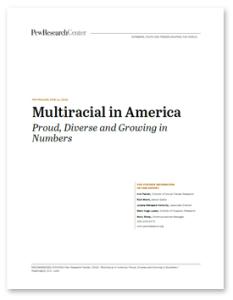
Author: Kramer, Marcia, Editor
Publication Year:
Media Type: Report
Summary:
This report, produced by Pew Research Center, examines the attitudes, experiences and demographic characteristics of multiracial Americans. The findings are based on data from two primary sources: A nationally representative survey of 1,555 multiracial Americans ages 18 and older, conducted online from Feb. 6 to April 6, 2015, and Pew Research analyses of data collected by the U.S. Census Bureau.
Abstract:
Multiracial Americans are at the cutting edge of social and demographic change in the U.S.—young, proud, tolerant and growing at a rate three times as fast as the population as a whole.
As America becomes more racially diverse and social taboos against interracial marriage fade, a new Pew Research Center survey finds that majorities of multiracial adults are proud of their mixed-race background (60%) and feel their racial heritage has made them more open to other cultures (59%).
At the same time, a majority (55%) say they have been subjected to racial slurs or jokes, and about one-in-four (24%) have felt annoyed because people have made assumptions about their racial background. Still, few see their multiracial background as a liability. In fact, only 4% say having a mixed racial background has been a disadvantage in their life. About one-in-five (19%) say it has been an advantage, and 76% say it has made no difference.
While multiracial adults share some things in common, they cannot be easily categorized. Their experiences and attitudes differ significantly depending on the races that make up their background and how the world sees them. For example, multiracial adults with a black background—69% of whom say most people would view them as black or African American—have a set of experiences, attitudes and social interactions that are much more closely aligned with the black community. A different pattern emerges among multiracial Asian adults; biracial white and Asian adults feel more closely connected to whites than to Asians. Among biracial adults who are white and American Indian—the largest group of multiracial adults—ties to their Native American heritage are often faint: Only 22% say they have a lot in common with people in the U.S. who are American Indian, whereas 61% say they have a lot in common with whites.
The U.S. Census Bureau finds that, in 2013, about 9 million Americans chose two or more racial categories when asked about their race.2 The Census Bureau first started allowing people to choose more than one racial category to describe themselves in 2000. Since then, the nation’s multiracial population has grown substantially. Between 2000 and 2010, the number of white and black biracial Americans more than doubled, while the population of adults with a white and Asian background increased by 87%. And during that decade, the nation elected as president Barack Obama—the son of a black father from Kenya and a white mother from Kansas.
The share of multiracial babies has risen from 1% in 1970 to 10% in 2013.3 And with interracial marriages also on the rise, demographers expect this rapid growth to continue, if not quicken, in the decades to come.
Yet the Pew Research survey findings suggest that the census’s estimate that 2.1% of the adult population is multiracial may understate the size of the country’s mixed-race population. Taking into account how adults describe their own race as well as the racial backgrounds of their parents and grandparents—which the census count does not do—Pew Research estimates that 6.9% of the U.S. adult population could be considered multiracial. This estimate comprises 1.4% in the survey who chose two or more races for themselves, an additional 2.9% who chose one race for themselves but said that at least one of their parents was a different race or multiracial, and 2.6% who are counted as multiracial because at least one of their grandparents was a different race than them or their parents. [Overview, p. 5-7]
Arts & Intersections:
Categories: Cultural Diversity
ADDITIONAL BIBLIOGRAPHICAL INFORMATION
PUBLISHER INFORMATION
Name: The Pew Charitable Trusts
Website URL: http://www.pewtrusts.com